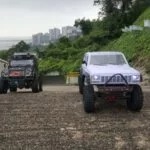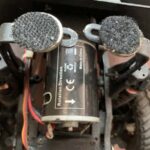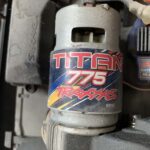Brushed RC Motors | 8 FAQuestions [Know Like a Pro]
At some point, we’ll all need to learn about the technologies that go into making a hobby-grade RC model.
Of course, this doesn’t just apply to beginners, but also pros, as technological advancement is always occurring, and it seems that every other day there is more to learn.
Today, we’re going to dive into the subject of brushed motors.
What Are Brushed RC Motors?
For those of you who are just starting out, learning the basic definition of a brushed motor is essential.
A brushed motor is an electrically powered component, mostly found in toy-grade RC models nowadays, but can still be used for hobby-grade models.
A brushed motor, like most other electric motors, is responsible for converting electrical energy into mechanical energy, which allows for the movement of your RC model.
How Do Brushed Motors Work?
Some of you who aren’t particularly technologically minded may be left scratching your heads over this topic.
Fear not, because the answer is simpler than you think, even if it seems intimidating at first.
A brushed motor is powered by a DC (Direct Current) source, such as a battery. The DC current flows through copper brushes, which are held in place against a commutator ring, and energizes two electromagnets inside of the brushed motor.
The commutator ring is segmented, meaning there are gaps on the edge of the ring, which reverses the polarity of the electromagnets when the brushes pass over the gaps and connect to the other segment of the ring.
The reason the magnetic polarity reverses is due to the brushes contacting the opposite sides of the commutator ring, which reverses the DC current’s flow, and in turn, reversing the polarity of the electromagnets. This creates perpetual rotation of the commutator ring.
Connected to the commutator ring are copper coils (the armature), and will rotate with the commutator ring as the electromagnets push and pull them. As long as a DC current is applied, the armature will continue to rotate, which means the brushed motor will continue to run.
What Are Turns?
This question is such a common one, so don’t feel silly for asking, as we’ve heard it a million times before.
Shockingly, this is a rather simple concept, and so too is the answer.
When you see something like “20T” in the description of an RC model, that is referring to the amount of turns that the motor possesses.
These “turns” are in reference to how many times copper wire has been wrapped around the armature of the motor, and depending on how high or low that number is, that could mean greater or lesser torque.
If your motor has twenty turns, it will have a lower RPM rating than a motor with ten turns, and this is due to the amount of resistance that larger quantities of copper wire produce. However, a higher number of turns means that your motor will have more power.
Do Brushed Motors Have More Torque Than Brushless Motors?
Brushed Vs. Brushless motors has been an ongoing debate for quite some time, but we won’t go into preferences or any form of subjectivity here.
Here are the bare facts about a brushed motor’s torque.
A brushed motor operates based on the brushes which contact the commutator ring at all times. As the commutator ring rotates, the brushes will create friction, which not only induces wear and tear, but also reduces torque.
With that taken into consideration, the brushless alternative will obviously have higher torque, as there are no brushes to create such friction. Therefore, brushed motors have less torque than more modern and standardized motors.
What Is A 540 Brushed Motor?
Whenever you look online for a new motor, chances are that you likely wondered what labels like “540” meant, in regards to describing the motor.
The number used in the description of the motor describes how large or small in diameter the body of a motor is. For example, a 540 motor is smaller than a 550 motor.
A motor with a longer body and a smaller diameter will run at a higher speed than a motor with a shorter body and larger diameter. In general, a motor that is larger has more torque, and motor that is smaller has less torque.
Brushed RC Motor Size Chart
Why do you need to know how big or small a motor is?
Not only is it important to know the size of a motor for the sake of space management in your RC model, but it’s also important to know the power behind each differently sized motor.
This chart covers some of the more common brushed motors.
| Model | Class | Size | Turns |
| Traxxas 7575X | 370 | Length: 31mm Diameter: 24mm | 28T |
| Injora 550 Brushed RC Motor | 550 | Length: 55mm Diameter: 36mm | Available: 12T, 21T, 29T, 35T |
| Traxxas 3975R | 550 | Length: 78mm Diameter: 37mm | 21T |
| TM-8019 | 540 | Length: 70mm Diameter: 36mm | 19T |
| T30 PRO | 540 | Length: 52.5mm Diameter:35.8mm | 30T |
Do You Have To Break In A Brushed Motor?
Whether you choose the wet method and partially submerge your brushed motor in water while it’s running, or the dry method and simply let your brushed motor run on a charger for 5 – 10 minutes, breaking in your motor can help to increase performance.
The purpose of breaking in a brushed motor is to seat the brushes properly on the commutator. If the brushes aren’t properly seated, the performance of your RC model may suffer.
However, the choice of whether or not you should break in a brushed motor is ultimately dictated by what level of performance you find is acceptable for your brushed motor to run at.
Are Brushed RC Motors Bad?
Even though brushed motors are ideal for those of you who are on a tight budget, they aren’t the standard for hobby-grade RC models nowadays.
To give you more of a summarized, clear point of reference, here are some of the disadvantages of owning a brushed motor:
• Brushed motors experience more wear and tear due to high friction.
• Brushed motors tend to have low RPM due to high friction.
• Brushed motors produce a large volume of noise.
• Brushed motors require more maintenance than brushless.
So, with all of the above considered, are brushed motors bad?
Brushed motors are widely regarded as inferior to their brushless counterparts, therefore, they are considered to be bad.
However, this does not mean that you can’t have fun with your brushed RC model, but you will need to be more attentive to your motor, and you will experience frequent difficulties.





